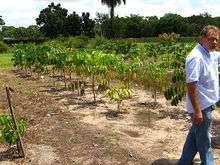Platonia
Platonia insignis, the sole species of the genus Platonia, is a tree of the family Clusiaceae native to South America in the humid forests of Brazil, Paraguay, parts of Colombia and northeast to Guyana; specially in Amazon Rainforest. Common names include bacuri (and numerous variant spellings thereof; bacurí, bacury, bakuri, pacuri, pakuri, pakouri, packoeri, pakoeri), maniballi, naranjillo and bacurizeiro.
| Platonia | |
|---|---|
| Scientific classification | |
| Kingdom: | Plantae |
| Clade: | Tracheophytes |
| Clade: | Angiosperms |
| Clade: | Eudicots |
| Clade: | Rosids |
| Order: | Malpighiales |
| Family: | Clusiaceae |
| Tribe: | Symphonieae |
| Genus: | Platonia Mart. |
| Species: | P. insignis |
| Binomial name | |
| Platonia insignis | |
| Synonyms | |
|
Aristoclesia esculenta Stuntz
| |

There was a degree of nomenclatural confusion, caused by Moronobea esculenta. If that were validly published for this species the current name would be Platonia esculenta. It was established that Moronobea esculenta is not a formal name (not "validly published"), so the name remains Platonia insignis.[1][2]
Platonia is related to Montrouziera[3] from New Caledonia.
Description
Platonia insignis is a dry-season deciduous tree, reaching 25–40 m high. It has a pyramidal crown and copious yellow latex in the bark. The leaves are opposite, simple oblong to elliptic, 8–15 cm long, and glossy dark green, with wavy margins and a leathery texture.
The flowers are 5–7 cm long and pink in color, with five petals and numerous stamens. The fruit is round to oval and 7–14 cm long, with a thick, yellow skin. It resembles a papaya. The rind exudes a yellow latex when pressed.[4] The sticky white pulp is fragrant, with a taste that is both sweet and sour. There are 3 to 5 seeds.
The white-bellied parrot (Pionites leucogaster) is a pollinator of the plant, making it ornithophilous.[5]
Cultivation and uses

The bacuri is grown for its fruit, which is made into various condiments and beverages. It contains high levels of phosphorus, iron, and vitamin C. The oily brown seeds are used as a home remedy to treat skin conditions. Its yellowish wood is frequently used as timber.
Oil and butter
The grease of the bacuri oil has a high absorption rate, due to its high level of tripalmitin (50% to 55%), which penetrates the skin quickly. The high amount of fatty palmitoleic acid (5%), compared to other oils (less than or equal to 0.5 to 1.5%), makes the bacuri oil useful as an emollient and moisturizing agent.[6]
Physico-chemical data
| Index | Unit | Reference value |
|---|---|---|
| Iodine Index | gl2/100g | 57 |
| saponification index | mgKOH/g | 211 |
| acidity | mgKOH/g | 10,71 |
| Index peroxide | meq/Kg | 5 |
| Fusion point | °C | 35 |
Chemistry
Platonia is a natural source of trioxygenated xanthones.[8] The latex contains resinotol.[9]
References
- van Rijckevorsel 2002.
- Kirkbride 2007.
- Ruhfel, B. R., V. Bittrich, C. P. Bove, M. H. G. Gustafsson, C. T. Philbrick, R. Rutishauser, Z. Xi, and C. C. Davis (2011). Phylogeny of the Clusioid Clade (Malpighiales): Evidence from the Plastid and Mitochondrial Genomes. American Journal of Botany 98: 306–25.
- Rogez, H., et al. (2004). Chemical composition of the pulp of three typical Amazonian fruits: araça-boi (Eugenia stipitata), bacuri (Platonia insignis) and cupuaçu (Theobroma grandiflorum). European Food Research and Technology 214(4) doi:10.1007/s00217-003-0853-6
- Cornell University Caique Glossary Archived 2007-10-27 at the Wayback Machine
- Morais, L. R. Banco de Dados Sobre Espécies Oleaginosas da Amazônia, não-publicado
- MORAIS, L. R. B.: Produção de óleo de duas espécies amazônicas por prensagem: Bacuri Platonia insignis (Mart.) e Pracachy Pentaclethra macroloba (Willd), 2005, Monografia em Curso de Mestrado Em Química Orgânica, Universidade Federal do Pará, Centro de Ciências Exatas e Naturais 76pp. Não publicada.
- Peres, V. and T. J. Nagem. (1997). Trioxygenated naturally occurring xanthones. Phytochemistry 44(2) 191-214. doi:10.1016/S0031-9422(96)00421-9
- "Platonia insignis". Archived from the original on 2011-07-18. Retrieved 2010-08-15.
Bibliography
- Clement, Charles (2006). "Platonia esculenta bacuri". In Jules Janick, Robert Paull (ed.). The Encyclopedia of Fruit and Nuts. Cambridge, MA: CABI. pp. 269–272. ISBN 9780851996387.
- van Rijckevorsel, Paul (November 2002). "(1564) Proposal to Conserve the Name Platonia insignis against Moronobea esculenta (Guttiferae)". Taxon. 51 (4): 813–815. doi:10.2307/1555050. JSTOR 1555050.CS1 maint: ref=harv (link)
- Kirkbride, Joseph H. (August 2007). "A 19th Century Brazilian botanical dictionary". Taxon. 56 (3): 927–937. doi:10.2307/25065874. JSTOR 25065874. Retrieved 11 May 2015.CS1 maint: ref=harv (link)
External links
| Wikimedia Commons has media related to Platonia esculenta. |